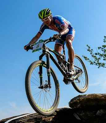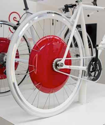By Karen Kefauver
August 9, 2013
Link to Sentinel Article
Nothing beats the thrill of whitewater rafting — not even speeding downhill on my mountain bike, though it sure comes close.
Envisioning a wild ride on whirling rapids instead of twisty trails, I sacrificed my Saturday cycling ritual and surrendered to the siren call of the American River. On Friday evening, on the first weekend of June, I packed a small bag with rafting essentials, bathing suit, hat, sunscreen and sunglasses, and left foggy Santa Cruz for sunny Sacramento. There, I met up with my pal, Hank Coffin, a former Santa Cruz resident who is always game for an outdoor adventure.
That night, we eagerly anticipated Saturday’s delicious blend of activities: a whitewater rafting day trip on the South Fork of the American River with the outfitter Outdoor Adventure River Specialists, followed by a gourmet dinner back at OARS’ seven-acre River Park Adventure Campground. Aptly named ‘Cork and Paddle,’ the trip was sure to end with a sumptuous organic meal and fine wine, no matter what happened on the river.
Since Hank had not been rafting since he was a kid and I had gone in Idaho several years ago, I spoke with confidence about what to expect on the rapids — though it turned out I was wrong on one key point.
Early Saturday morning, we drove a leisurely hour from Sacramento to Lotus, a small community in El Dorado County. It’s in the heart of California Gold Rush country and recently became the new headquarters of OARS. A pioneer in the rafting industry, OARS launched more than 40 years ago by George Wendt and currently offers national and international rafting and multi-sport tours.
We pulled into the OARS parking lot just in time to grab a coffee and pastries at the nearby Sierra Rizing Cafe and Bakery, though it would turn out we did not need the caffeine; adrenaline would do the trick. Hank and I reported to the 10 a.m. OARS safety meeting, a mandatory part of the rafting trip, to learn about the gear, the guides, the river and taking care of each other on our inflatable yellow rafts.
An amiable employee described the hazards we might encounter on the South Fork of the American River, which is designated as Class III, suitable for beginners and intermediate rafters. The inexact classification system for whitewater rivers ranges from Class I, moving waters with small waves, to Class VI, nearly impossible, life-threatening roiling rapids. Given the lack of rain, I believed we would not have high water, but I was mistaken. I learned that the water levels of the South Fork are controlled by hydroelectric facilities upriver, assuring sufficient water flow for heart-pumping rapids. I quickly realized the rapids would be more exciting than I had imagined.
We were warned that whacking each other with our paddles in the boat was a far more likely danger than our boat capsizing or us tumbling into the water. Nevertheless, we practiced on land how to rescue one another or perform a “self-rescue” should we plunge over the side. I snuck a look at Hank and about two dozen other paddlers who would be in the water together, four to seven passengers to a boat, along with a guide. We all looked super serious.
But the mood soon lightened as we snapped into snug orange life vests, adjusted our sporty red helmets, and clutched our sturdy paddles, all supplied by the outfitter. I was happy that the weather was warm enough not to need a wetsuit, though the water was only about 60 degrees. We walked through the shady campground to the put-in at Beaver Point.
Marcelo Granados, our raft guide, and five other guests, gathered for a little pep talk before pushing off into calm waters. We would become like a little family for the afternoon, watching out for each other, Marcelo explained.
He showed us the basic paddle strokes and explained the commands he would issue from the back of the boat as our trusted commander-in-chief. Then we glided onto a 13-mile stretch of river.
As we floated and gently paddled for the first four miles, I recalled why I love rafting. For me, it’s not all about the rapids, as exciting as they are. Just being on the water and letting all my cares and worries float away while gazing at the scenery is deeply relaxing. I get to unplug since you don’t want electronics (save perhaps, a waterproof camera) on the water, so I was not checking my phone or fiddling with Facebook.
I was deeply immersed in watching the eddies of the water and scanning the river banks for animals. We spotted turtles and Canadian geese. I scanned the cliff bluffs for deer and felt at ease that the area was less developed than I previously thought.
For scenery, there was plenty of action on the river: other rafters, including one boat of guys dressed as pirates, solo daredevils in kayaks and paddle boats with oars.
I snapped to attention when Marcelo announced that our first rapid was coming up fast — the first of 11 named rapids on this stretch of river. We could hear the rushing waters ahead and gripped our paddles tightly. Our boat dipped forward and it felt like a rollercoaster entering the descent. We shouted with excitement and shock as the cold water slapped us awake and the nose of the boat dipped down. We practiced our team dynamics as we all paddled hard and fast at the same time to navigate the Class II rapid. It was perfect preparation before hitting the bigger rapids like Satan’s Cesspool and Hospital Bar later on. At one point, our guide delighted us by maneuvering us into a 360-turn, not an easy move, while going through the rapid.
Soon after, we got even more whitewater and that whet our appetite. We stopped for lunch on a sandy shore and met Michael Dotson of the American River Conservancy. As part of being an environmentally responsible company, OARS encourages its guests to make a small, voluntary donation to the Conservancy Fund.
The highlight of the day for me was watching Hank sit in the front row of the raft, always the spot guaranteed the most whitewater action, and laughing with glee as huge planes of water crashed over him, drenching him. I was delighted to introduce him to the pure joy of immersion in whitewater rafting.
Speaking of immersion, we did voluntarily jump over the side of the boat in calm waters, but otherwise we all stayed seated with the boat upright. I took my turn in the front row, also, and squealed and gulped through the rapids, loving when the boat felt like a bucking bronco.
As we neared the end of the run we saluted one another with the signature paddle “high-five.” We raised our paddles to touch overhead in a testament to the great hours we had shared together on the water. We had swapped stories, helped each other in and out of the boat and made plans for our next rafting adventures. I loved the camaraderie.
By late afternoon, we were back on shore and a bus ride returned us to camp, where we awaited a fine dinner prepared by a guest chef and regional vintner. The meal was delicious, but nothing satisfies me as much as leaving my day-to-day cares on shore and plunging into nature as I bounce down the river like a happy kid.
Karen Kefauver (www.karenkefauver.com) is a freelance writer who covers sports and travel. View her stories on the Sentinel’s Out and About blog at www.santacruzsentinelcom/blogs. For more information about whitewater rafting trips, contact OARS at 209-736-4677 or [email protected] or visit www.oars.com.


